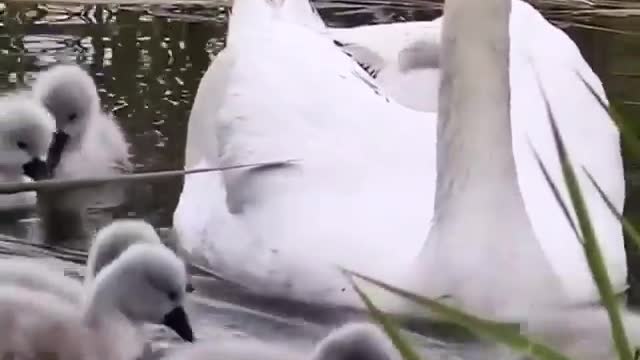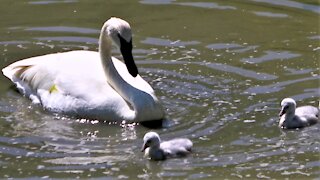Premium Only Content

Swan parents teach young how to stir up food in the pond
Trumpeter swans are magnificent birds that can reach an incredible size with a wingspan of more than 2.5m (8 feet). They are the largest bird native to North America, growing to more than 13kg (30 pounds) in weight. Although the young will eat insects as well as plants, these birds are herbivores once they reach maturity. They feed mainly on water plants and algae, foraging beneath the surface for aquatic plants and roots.
These swans are stomping the mud with their feet to clear and loosen the soil around the underwater roots. They eat pieces of plants that rise to the surface and they also reach underwater to twist and bite plants and roots that have been made accessible. The babies are taking advantage of their parents' efforts and watching closely to see how it is done.
Although they are tagged, these are wild swans that have been released as part of a breeding program at the Toronto Zoo in Ontario, Canada. The tags help to track the birds and evaluate the success of the mating pairs, as well as providing valuable information for future conservation. Trumpeter swans usually mate for life and they will often return to this pond at the zoo after release. The zoo provides ideal habitat for breeding and raising the young, known as cygnets. Both makes and females courageously defend the young for 3-4 months. A unique behaviour of the trumpeter swan is prolonged thrashing of the water with their wings and feet in what is believed to be a deterrent for snapping turtles that would prey on the vulnerable young cygnets.
Trumpeter swans came dangerously close to extinction in the 1930s when it was believed that there were as few as 70 individuals. A population was discovered in Alaska and conservationists and wildlife agencies teamed up to assist in breeding and reintroduction. Healthy populations have been restored throughout North America.
While most people understand the issues of concern that exist with some zoos around the world, there is also a very positive side that is less understood. Organizations like the Toronto Zoo play a vital role in understanding, and conserving wildlife around the planet. Through education, volunteering, funding, and providing critical expertise, we have been able to reverse some of the catastrophic effects of human population growth.
-
 1:26
1:26
WildCreatures
3 years ago $0.74 earnedSwan parents teach young how to stir up food in the pond
5.05K29 -
 2:54
2:54
KGUN
3 years agoWill parents get young children vaccinated?
691 -
 0:14
0:14
TheSim Basement Fitness
3 years agoTeach Em Young - Future Marine?
531 -
 1:11
1:11
The Post Millennial Live
3 years agoNBC's Today show does a segment where they teach parents how to mask their children
6.75K16 -
 2:39
2:39
KTNV
3 years agoParents react to how White House plans to vaccinate young kids
441 -
 0:17
0:17
Mr Producer Media
3 years agoTerry McAuliffe: Parents Shouldn't Tell Schools What They Should Teach
1.64K17 -
 2:21:11
2:21:11
Nerdrotic
17 hours ago $37.04 earnedDown the Rabbit Hole with Kurt Metzger | Forbidden Frontier #090
168K35 -
 2:41:13
2:41:13
vivafrei
23 hours agoEp. 251: Bogus Social Security Payments? DOGE Lawsduit W's! Maddow Defamation! & MORE! Viva & Barnes
281K307 -
 1:19:23
1:19:23
Josh Pate's College Football Show
16 hours ago $5.35 earnedBig Ten Program Rankings | What Is College Football? | Clemson Rage| Stadiums I Haven’t Experienced
81.9K1 -
 13:22:09
13:22:09
Vigilant News Network
21 hours agoBombshell Study Reveals Where the COVID Vaccine Deaths Are Hiding | Media Blackout
130K69